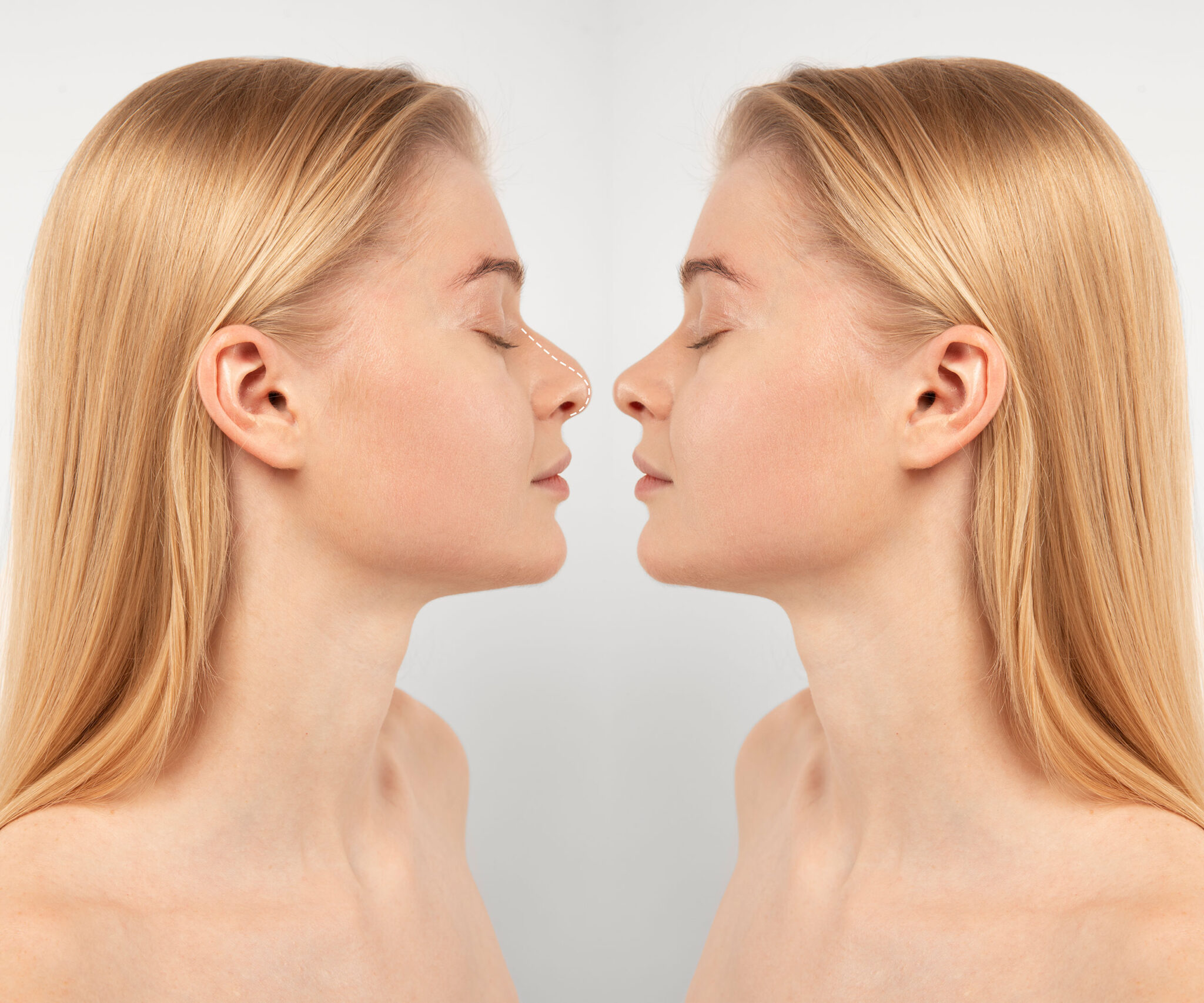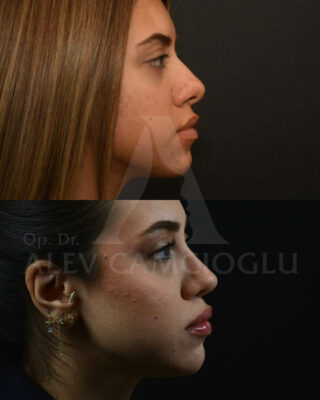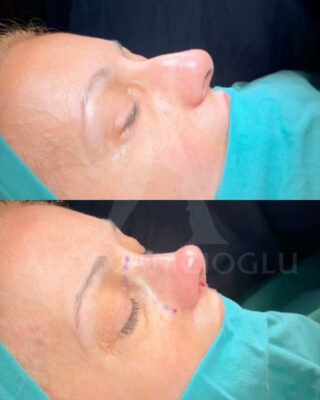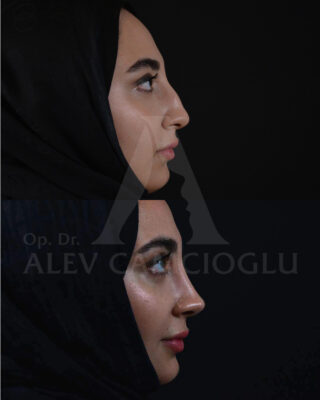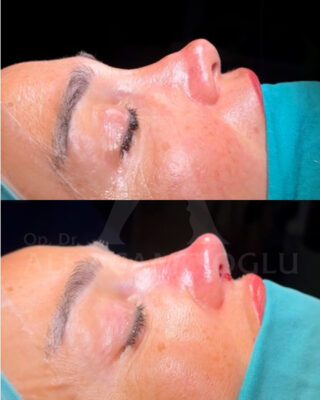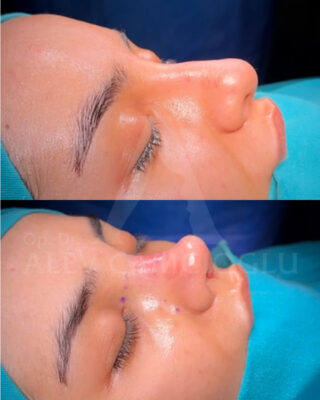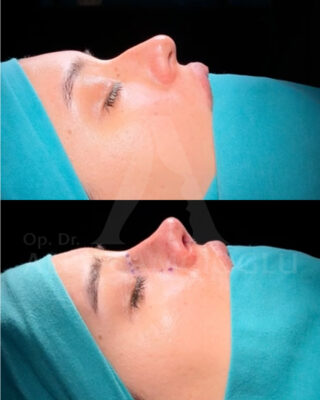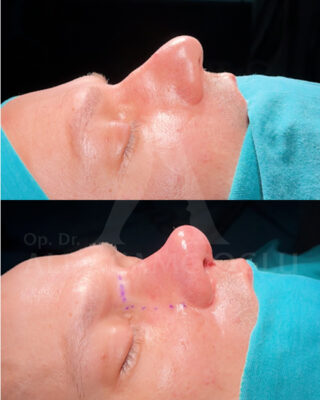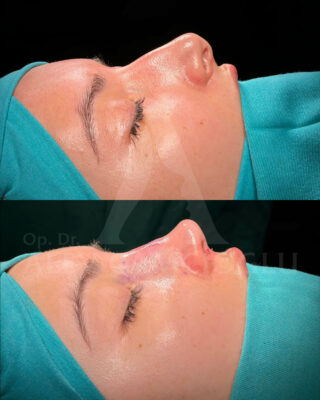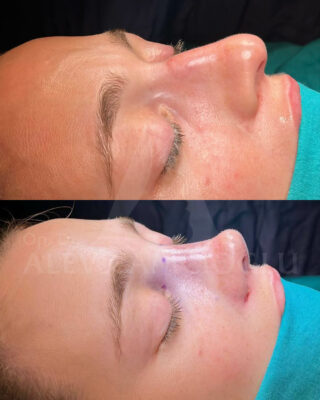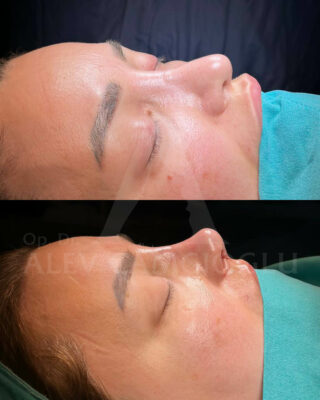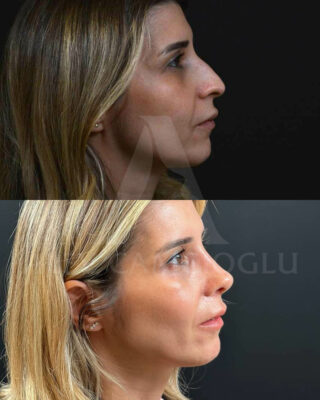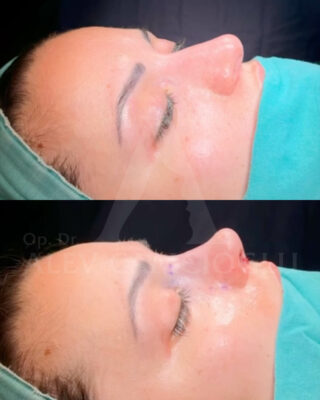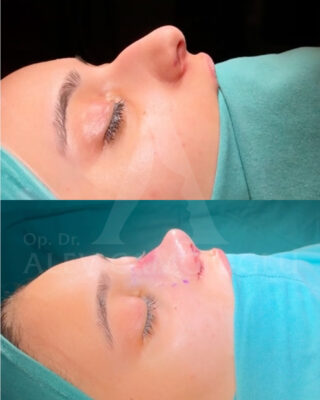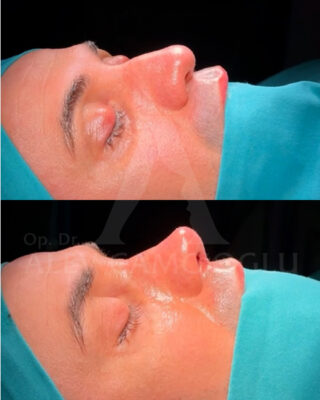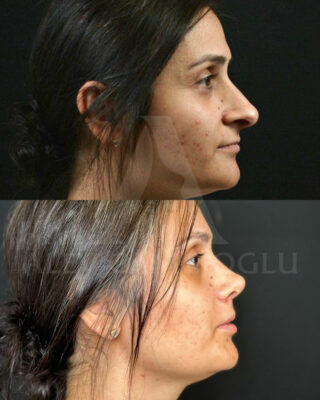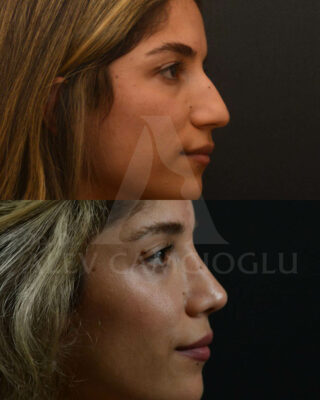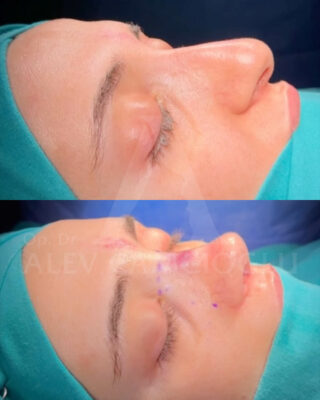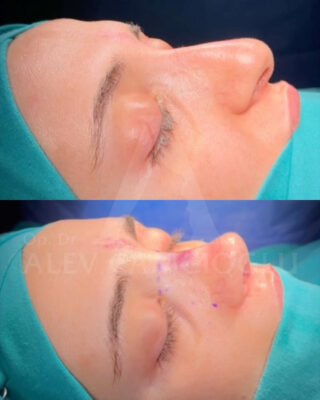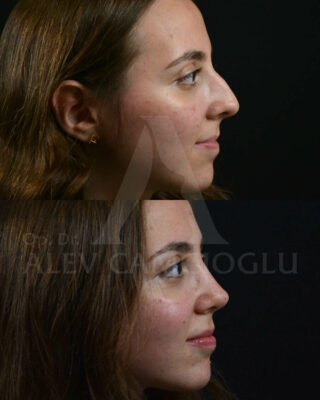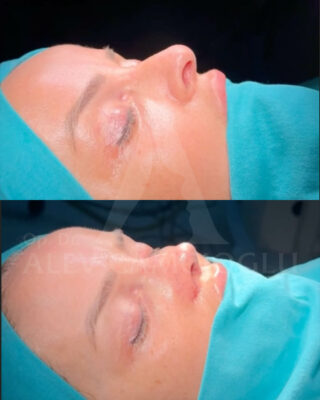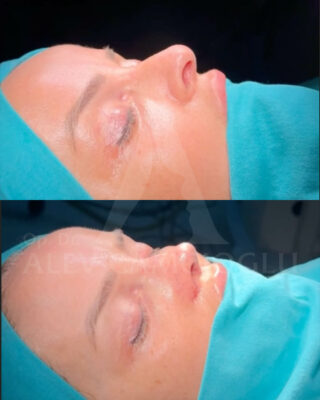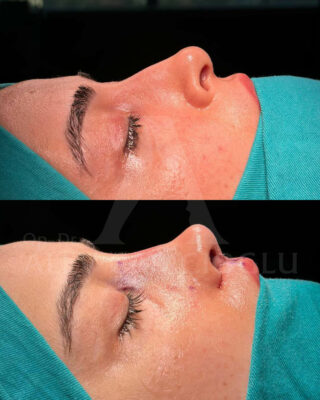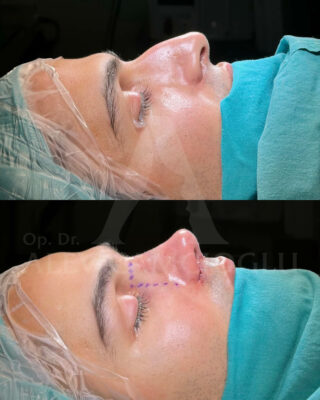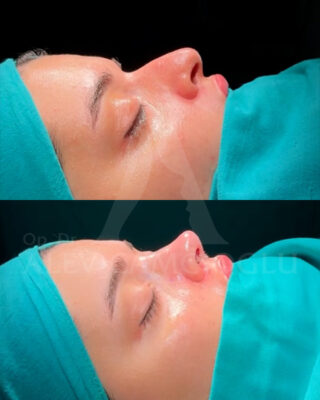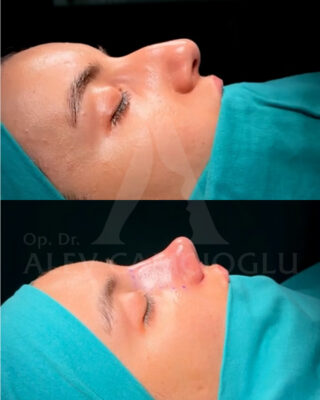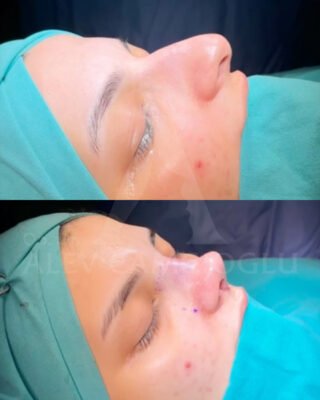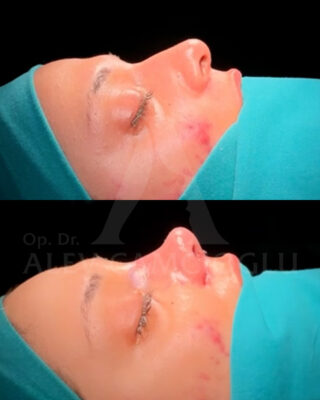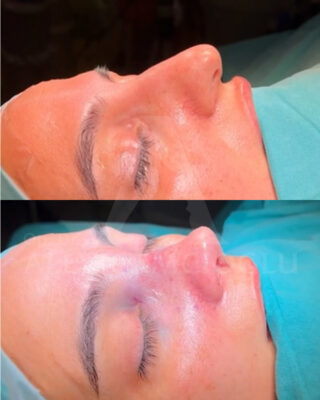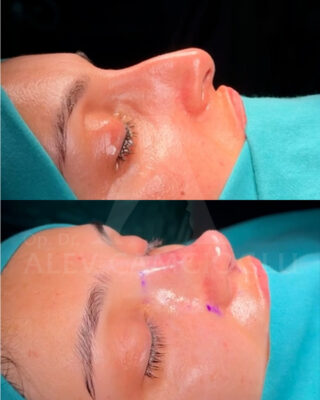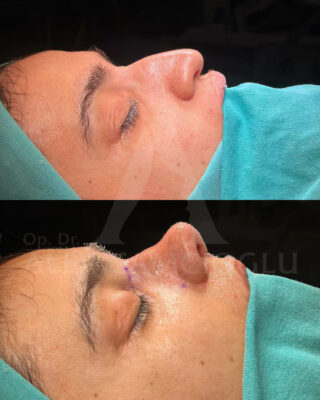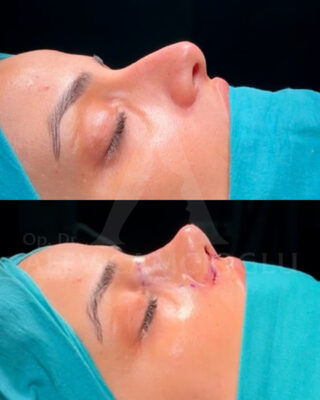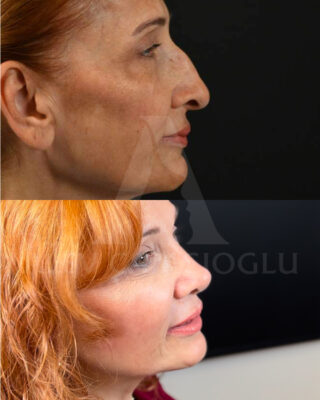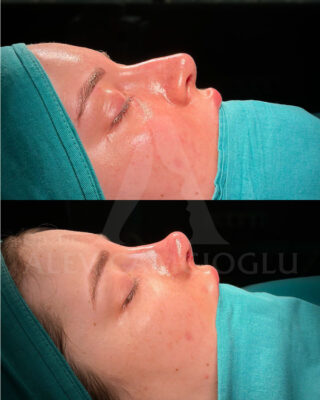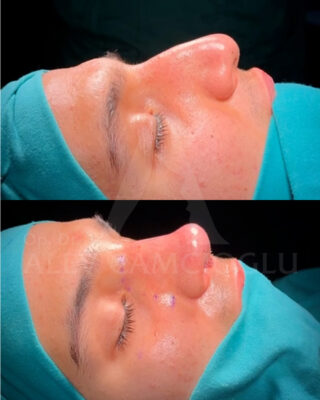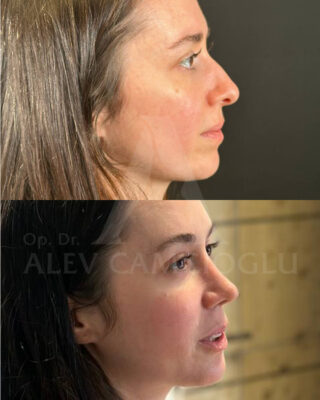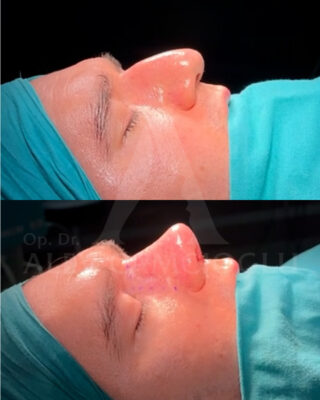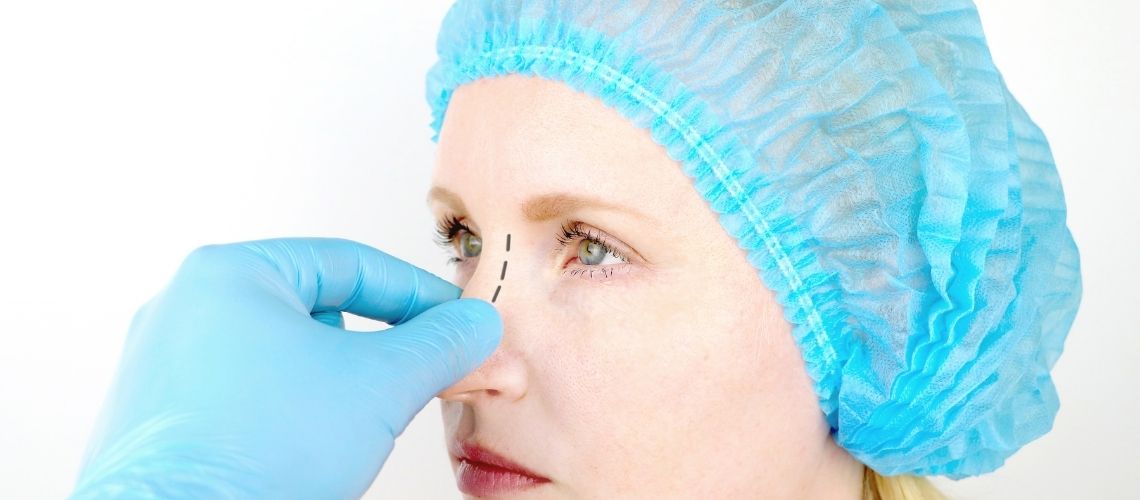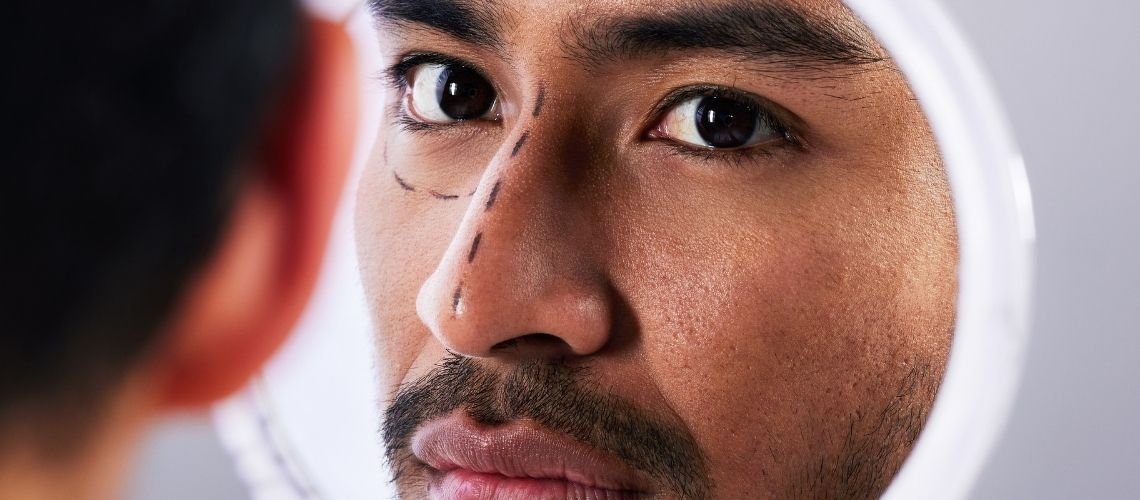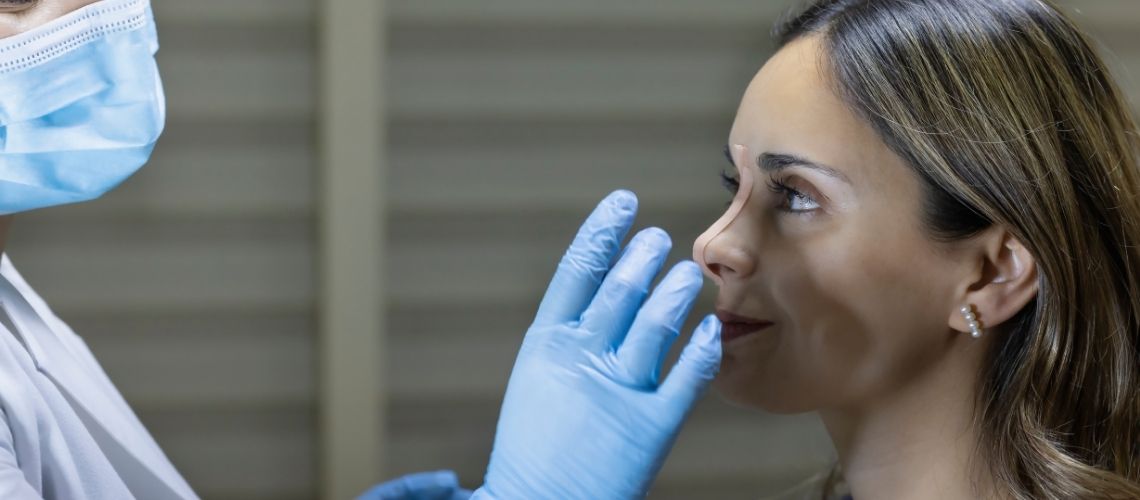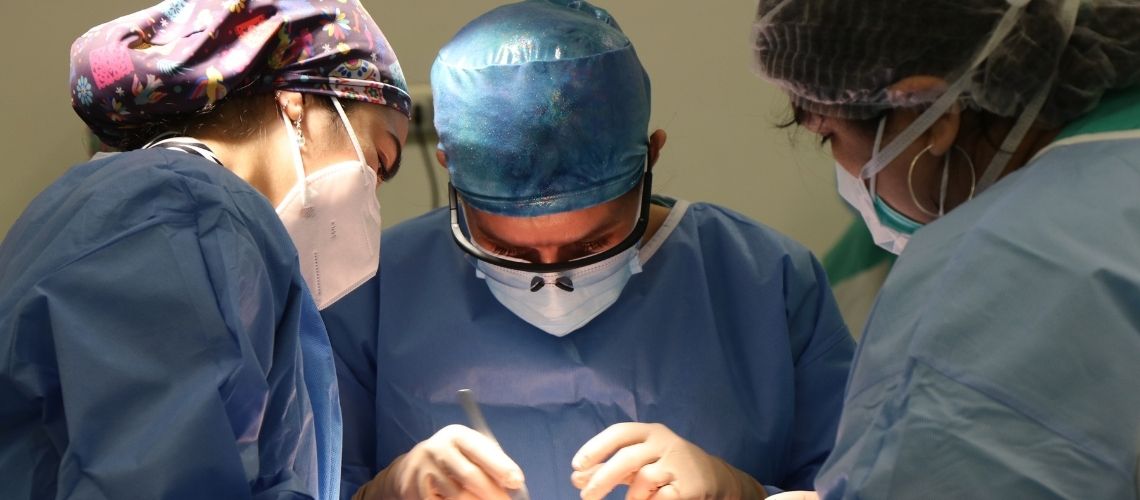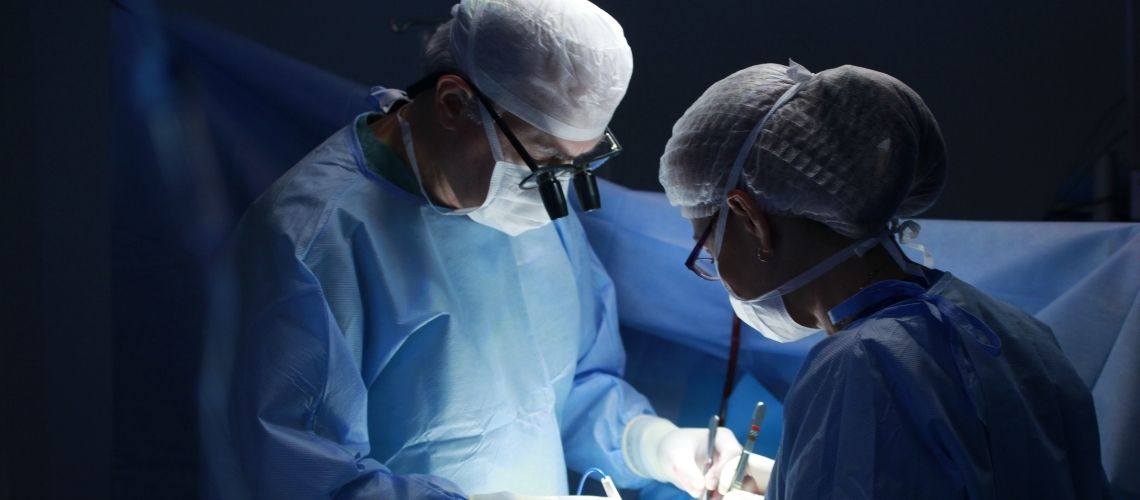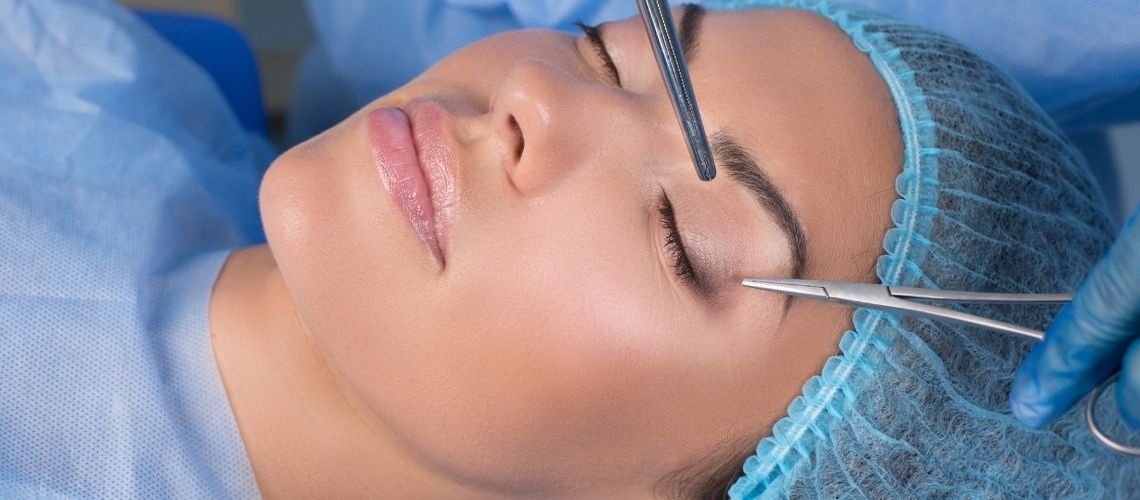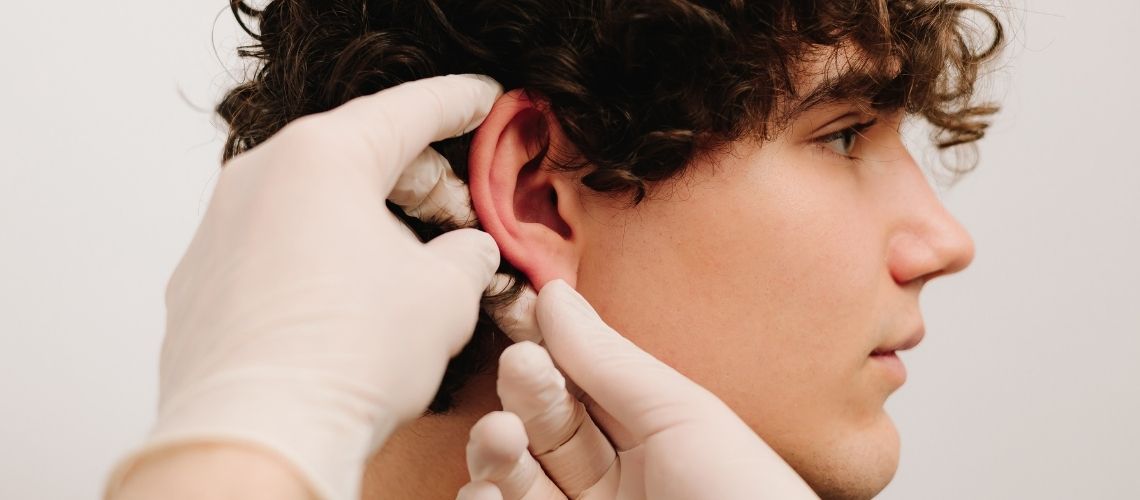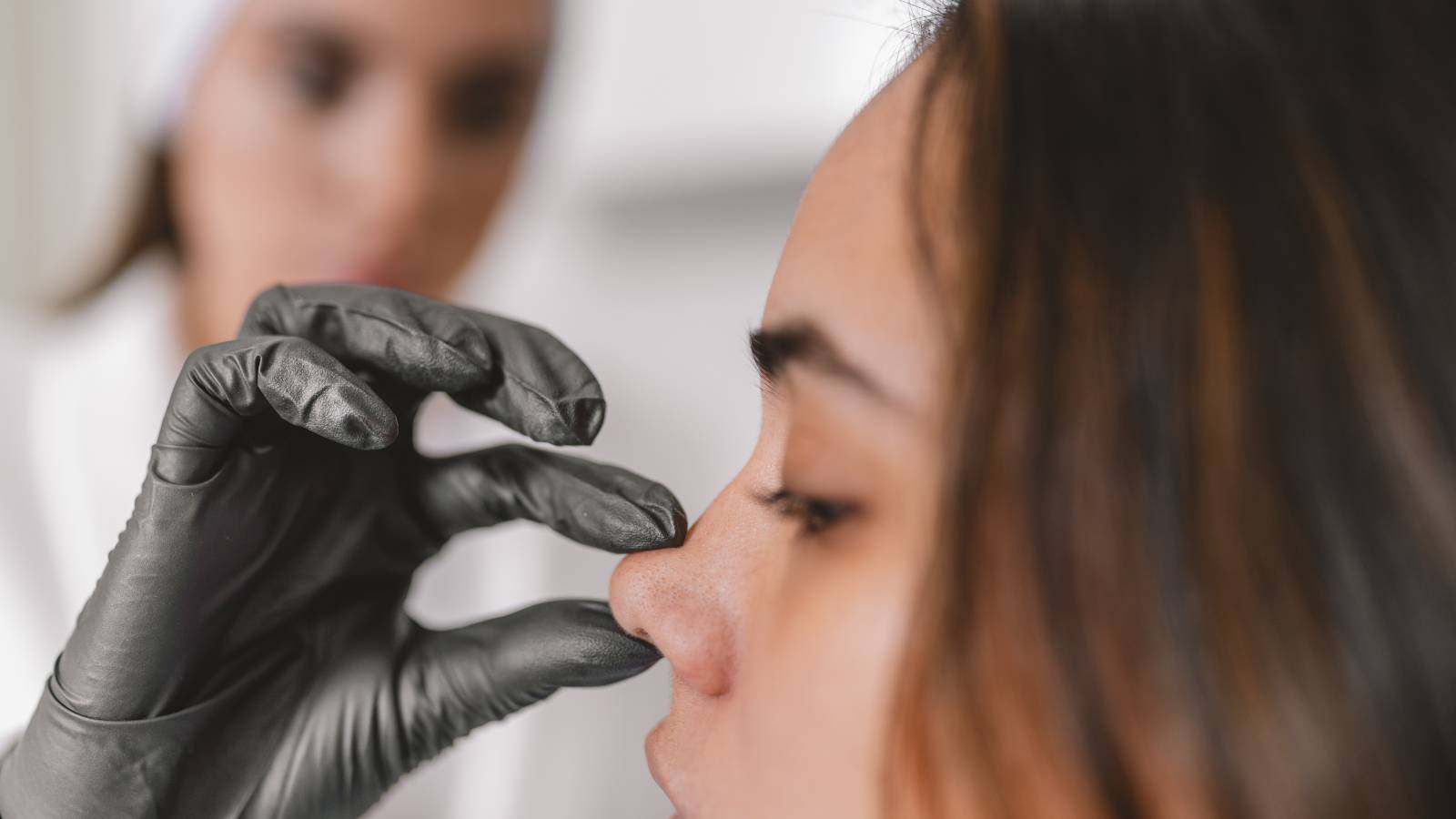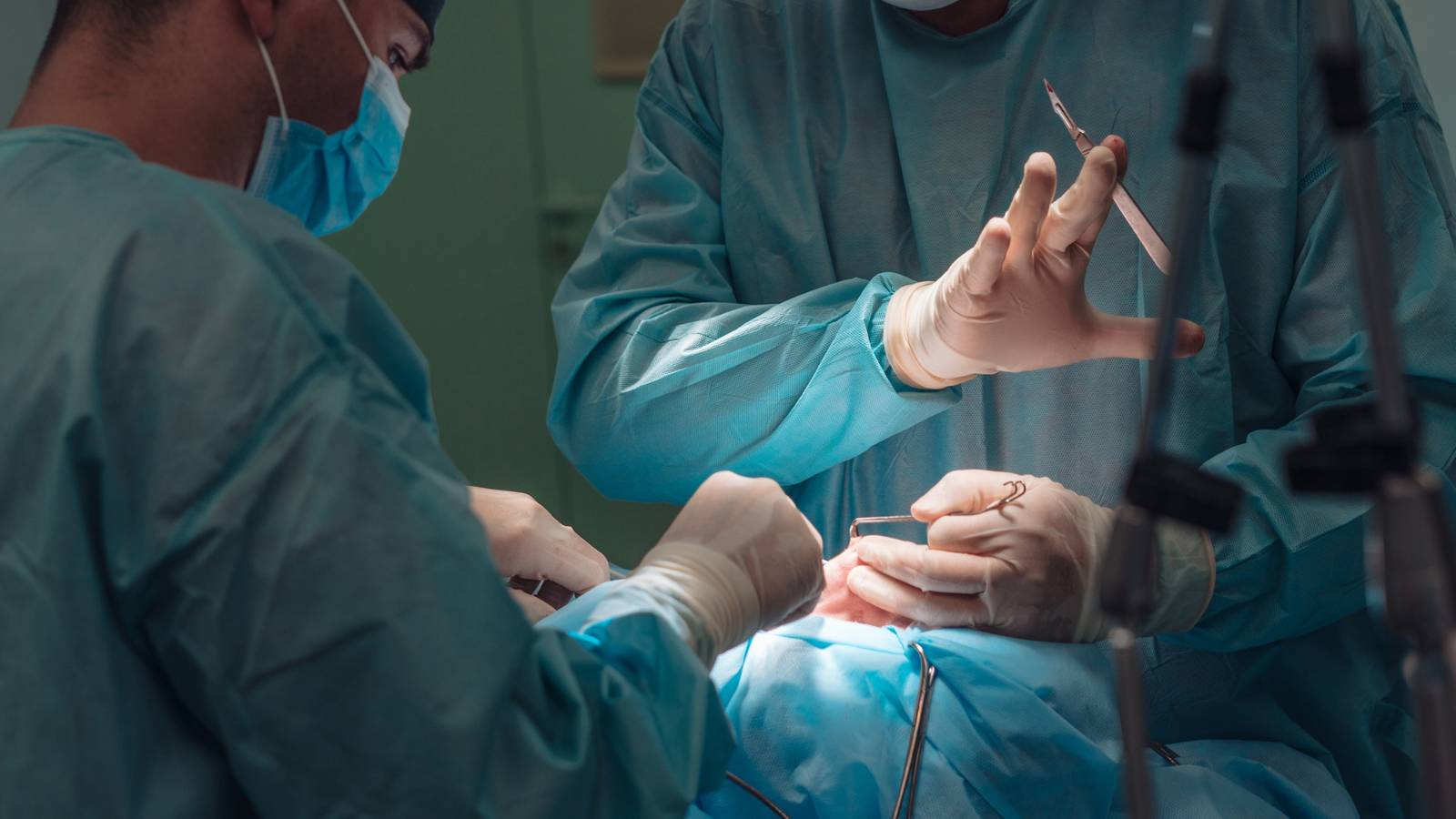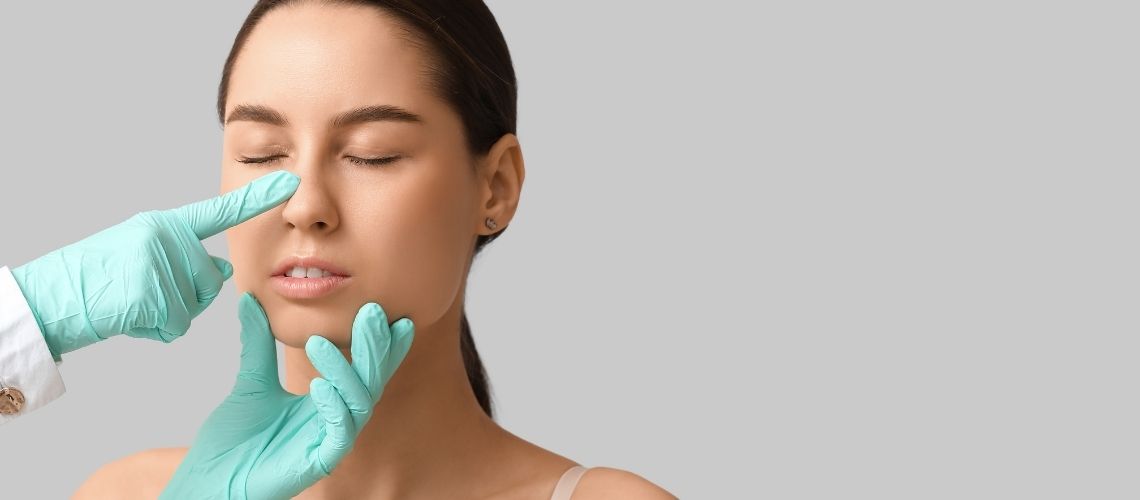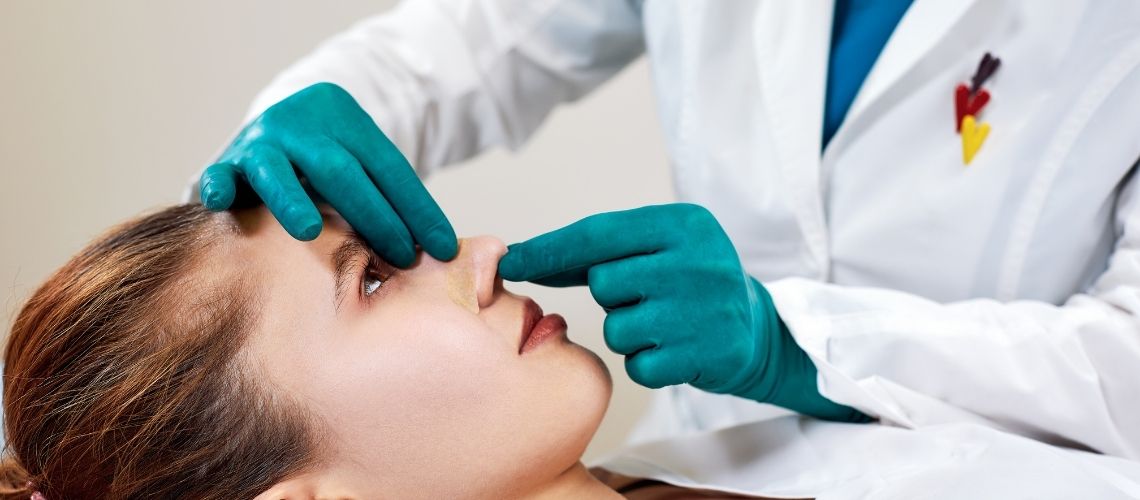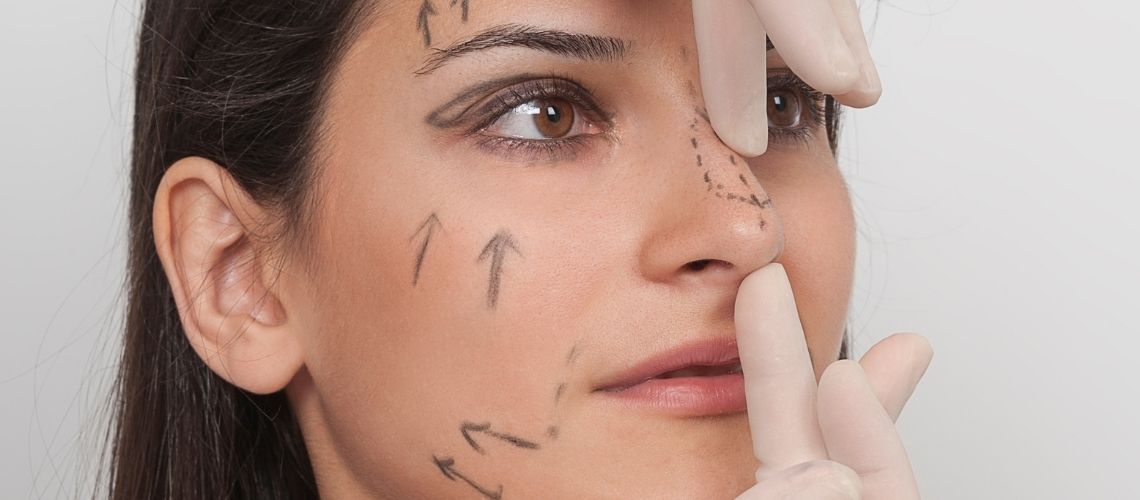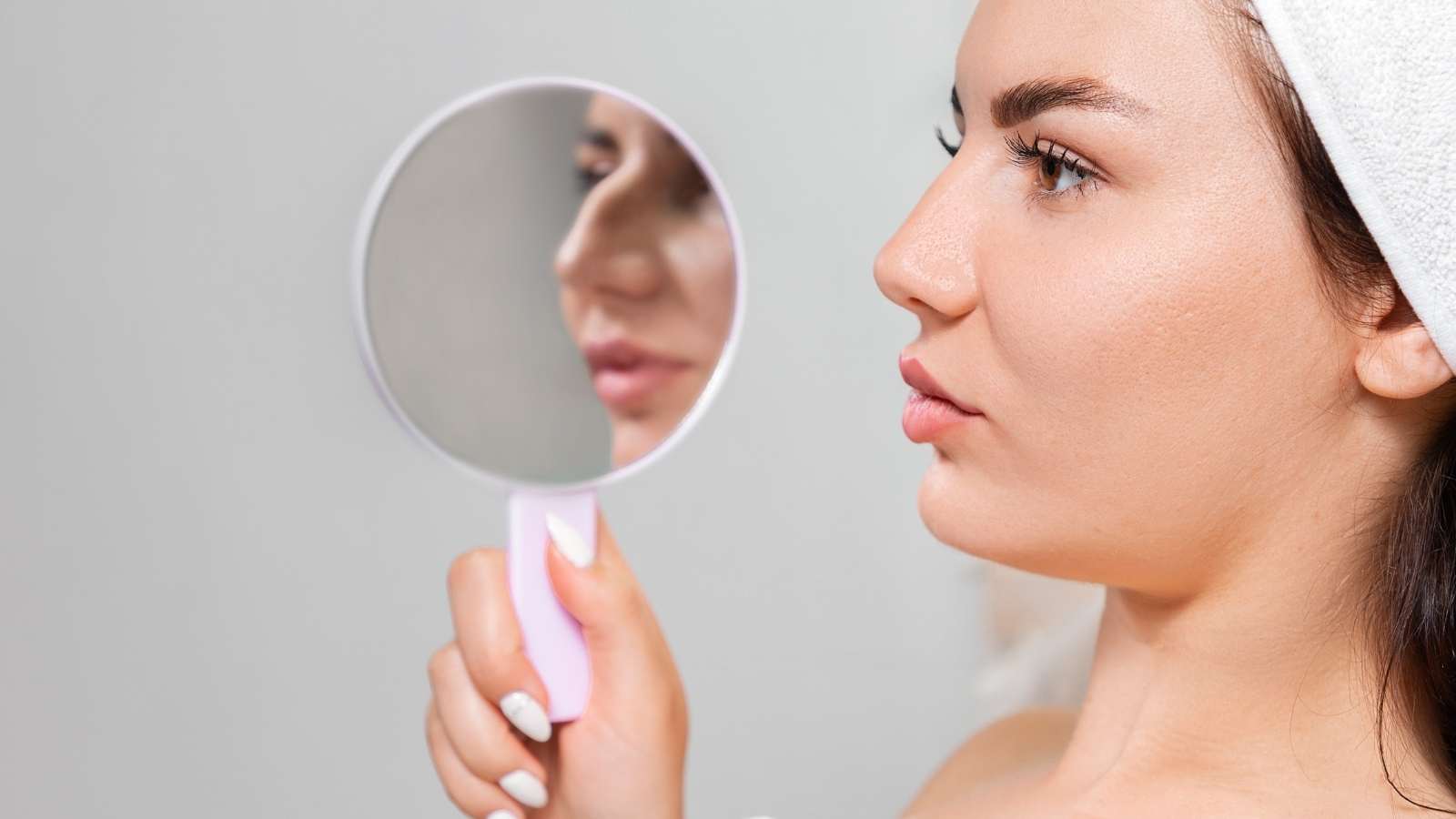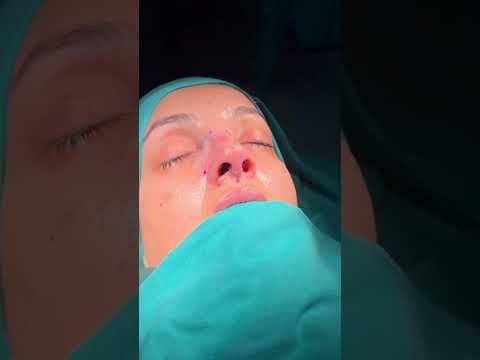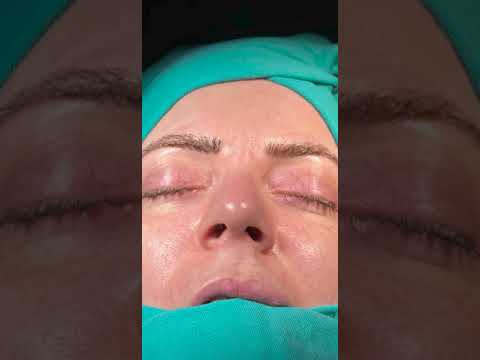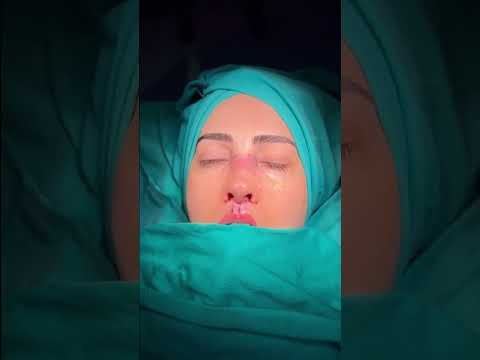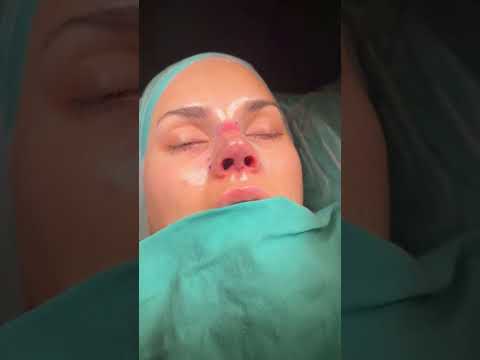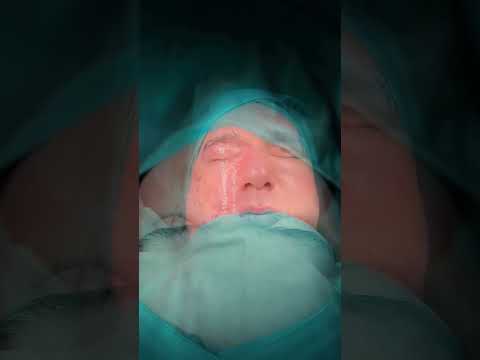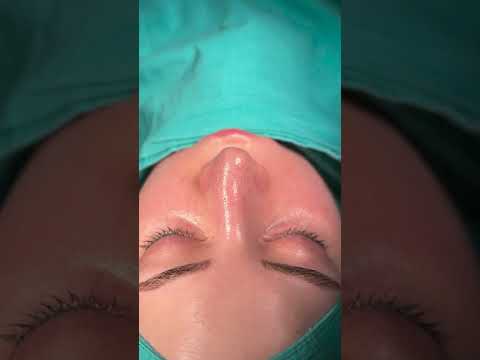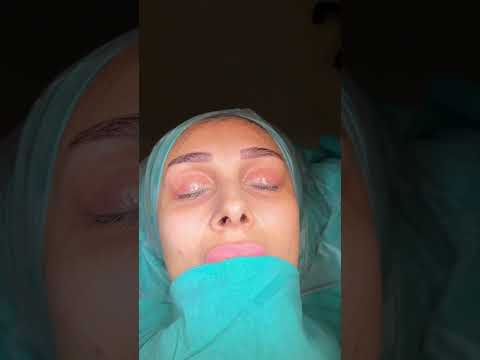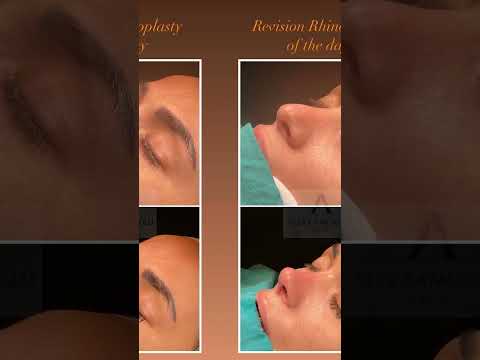Alarplasty in Turkey
Refine the shape and size of your nostrils with Alarplasty in Turkey at Dr. Camcıoğlu’s practice. This procedure focuses on adjusting the alar base to reduce nostril flare, contributing to a more balanced and symmetrical nasal appearance. We ensure subtle yet impactful results tailored to your aesthetic preferences.
Cost of Alarplasty in Istanbul, Turkey ranges between €5,000– €7,000 in 2025 depending on hospital, package, and anatomy of your nose. Check our prices, before & after photos, and patient results from the USA, UK, Canada, Australia, and the rest of the world.
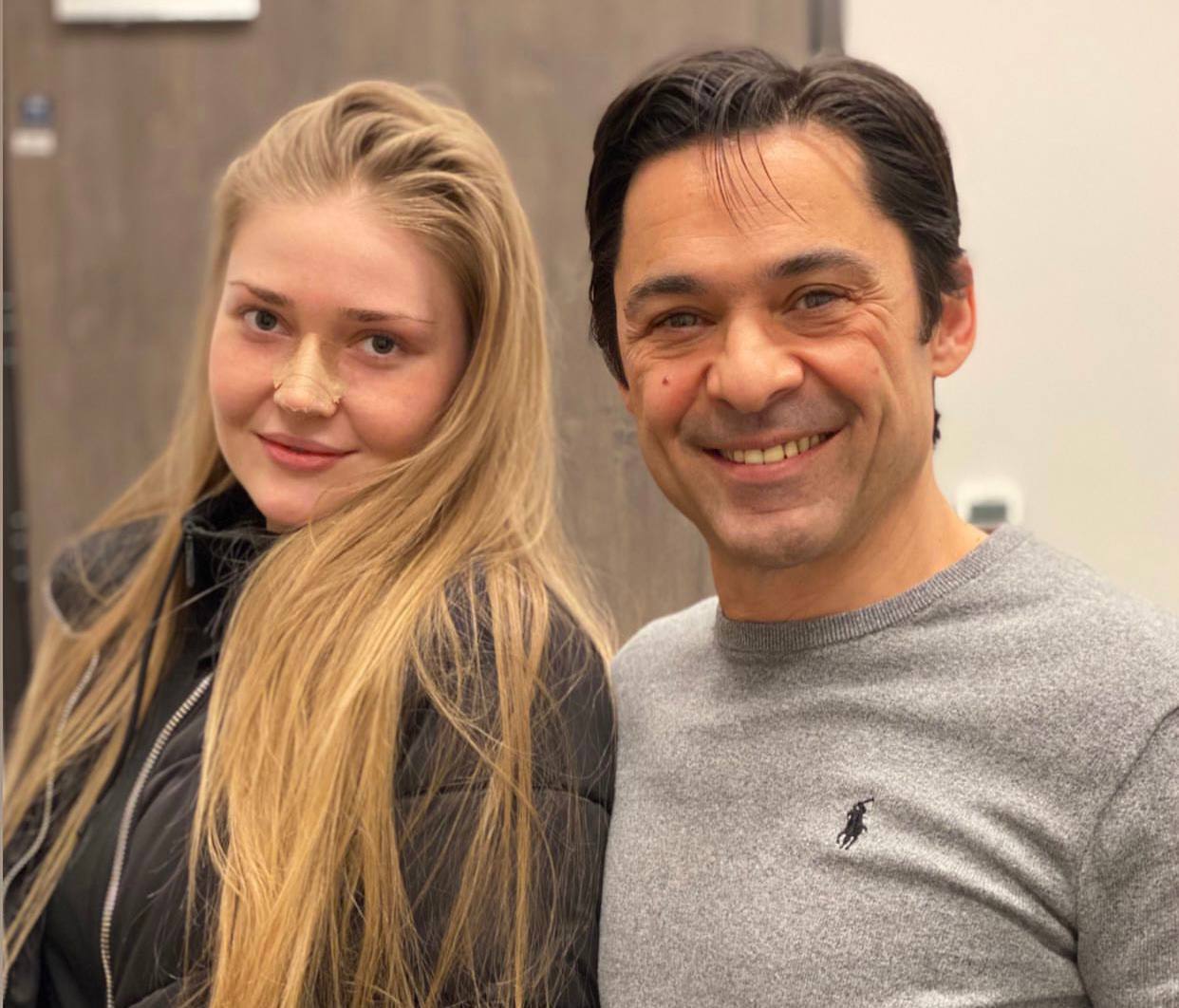
What is Alarplasty and What Cutting Techniques Are Used?
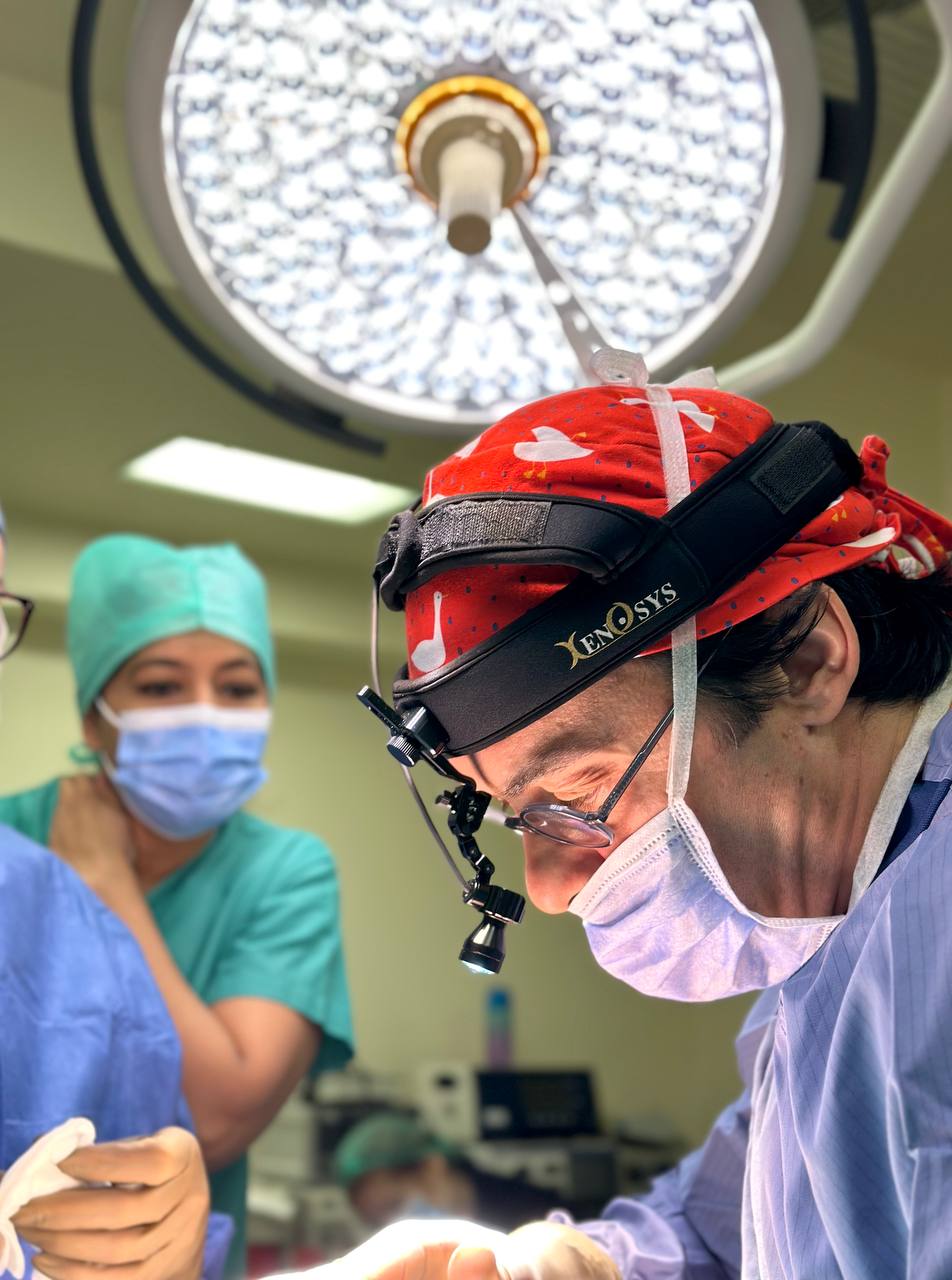
Alarplasty is a surgical intervention primarily performed for aesthetic purposes. Generally, this procedure involves removing a small piece of skin from the nasal wing, narrowing the nasal base. As a result, the nose gains a thinner and more aesthetic appearance. The procedure helps eliminate disproportions in the nasal structure. It can also have positive effects on respiratory functions.
The cutting techniques used in the nasal wing reduction procedure are as follows:
Wedge Technique:
- A wedge-shaped piece is removed from the lower curved part of the nasal wing.
- This technique is aimed at reducing the width of the nose.
- The incisions are usually made externally and do not narrow the nostril.
Sill Technique:
- It aims to narrow the base of the alae to reduce the width of the nostril.
- The incisions are made from inside the nose.
- This method is usually combined with the wedge technique.
Weir Technique:
- Developed by Weir, this technique is considered an improvement of the wedge technique.
- An excision is made to conform to the curve of the nostril.
- Sutures are used to create contours.
The decision on which cutting technique to use during the surgical process is determined based on the patient’s current nasal structure and the desired outcomes. Alarplasty, aimed at achieving the most natural appearance possible, is considered a subfield of rhinoplasty. Approximately 220,000 people choose this procedure annually.
What Are the Types of Alarplasty?
Alarplasty is a nasal base reduction surgery that focuses on reshaping the nostrils or narrowing the alar base. The main types include:
- Wedge Excision Alarplasty
- Weir Excision Alarplasty
- Sill Excision Alarplasty
- Combined Wedge and Sill Alarplasty
- Internal (Hidden Incision) Alarplasty
- External Alarplasty
- Closed Alarplasty
- Open Alarplasty
- Asymmetric Alarplasty
- Alarplasty with Nostril Reduction
Suitable Candidates for Nostril and Wing Reduction Surgery
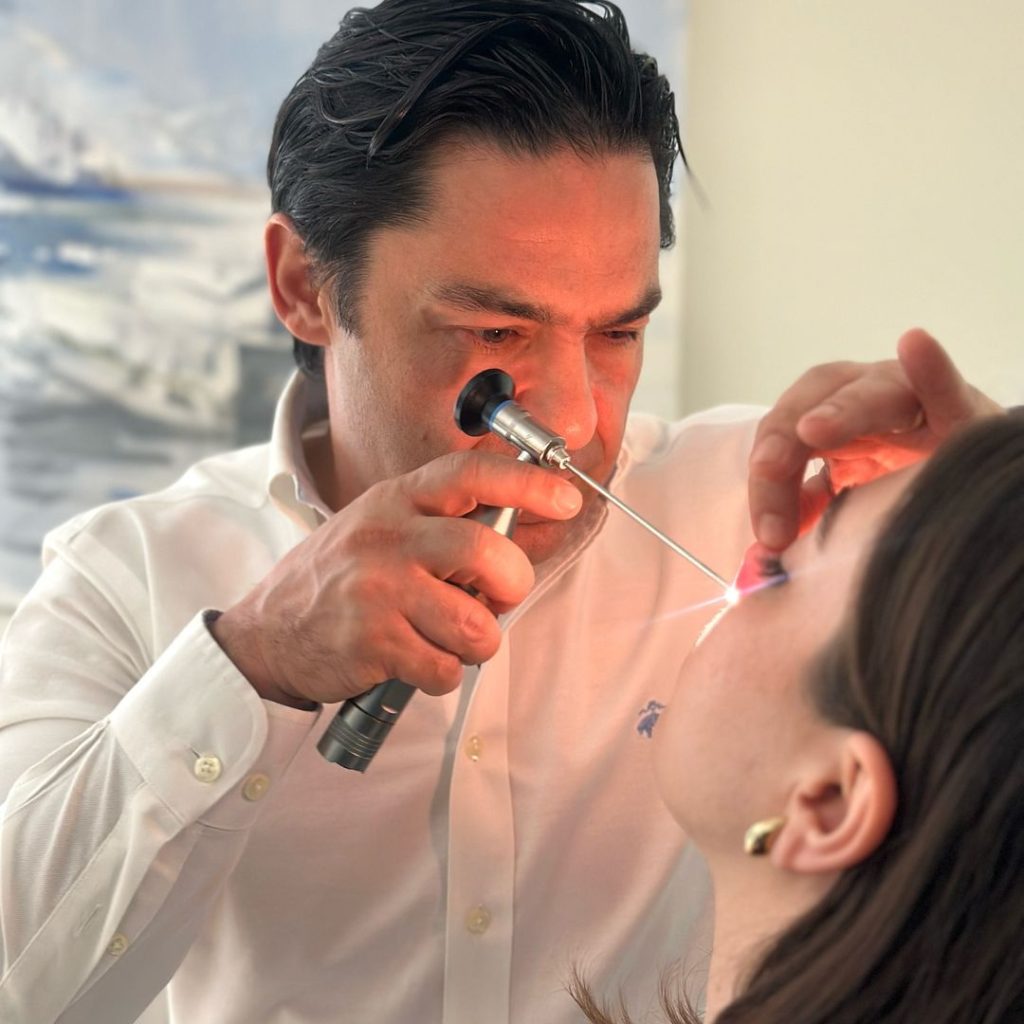
Nostril reduction surgery aims for aesthetic and functional improvements. This procedure aims to increase facial symmetry and address breathing problems. Before the operation, the specialist doctor thoroughly evaluates the patient’s overall health status. Thus, it is determined whether the candidate is suitable for this intervention. Individuals who want to change the size or shape of their nostrils for aesthetic reasons generally have the following characteristics:
- Individuals over 18 years old are considered the primary candidates for this operation.
- Those with good overall health are considered suitable for surgical intervention.
- Those with nostrils or wings that appear disproportionate to the facial structure may prefer this surgery.
Other candidates for this procedure are individuals with anatomical issues that negatively affect respiratory functions. Narrow nostrils can cause breathing difficulties, which can be corrected with this operation. Additionally, it is suitable for those who want to achieve an aesthetic balance in their nostrils or wings. Such adjustments ensure a more balanced and proportionate facial appearance.
The operation is also suitable for individuals with the following conditions:
- Those who have previously undergone rhinoplasty and want to improve the results.
- Individuals who have suffered a traumatic facial injury.
- Those with congenital deformities or asymmetries of the nostrils.
The alarplasty procedure targets the fleshy parts connecting the nostrils, known as alae. The size and shape of these wings can vary depending on the natural structure of the face. The operation reduces the width of the nose by removing part of these wings, resulting in a more aesthetic appearance.
Candidates for this procedure have the following characteristics:
- Non-smokers have an advantage in the post-operative healing process.
- Full recovery from previous surgical procedures.
- Realistic expectations about the impact of a cosmetic procedure on appearance.
The best way to determine if this procedure is suitable for you is to consult with a board-certified plastic surgeon. During this consultation, factors such as your specific health conditions and past cosmetic surgeries are taken into account. This helps better assess the potential outcomes of this surgery.
How is the Alarplasty Procedure Performed?
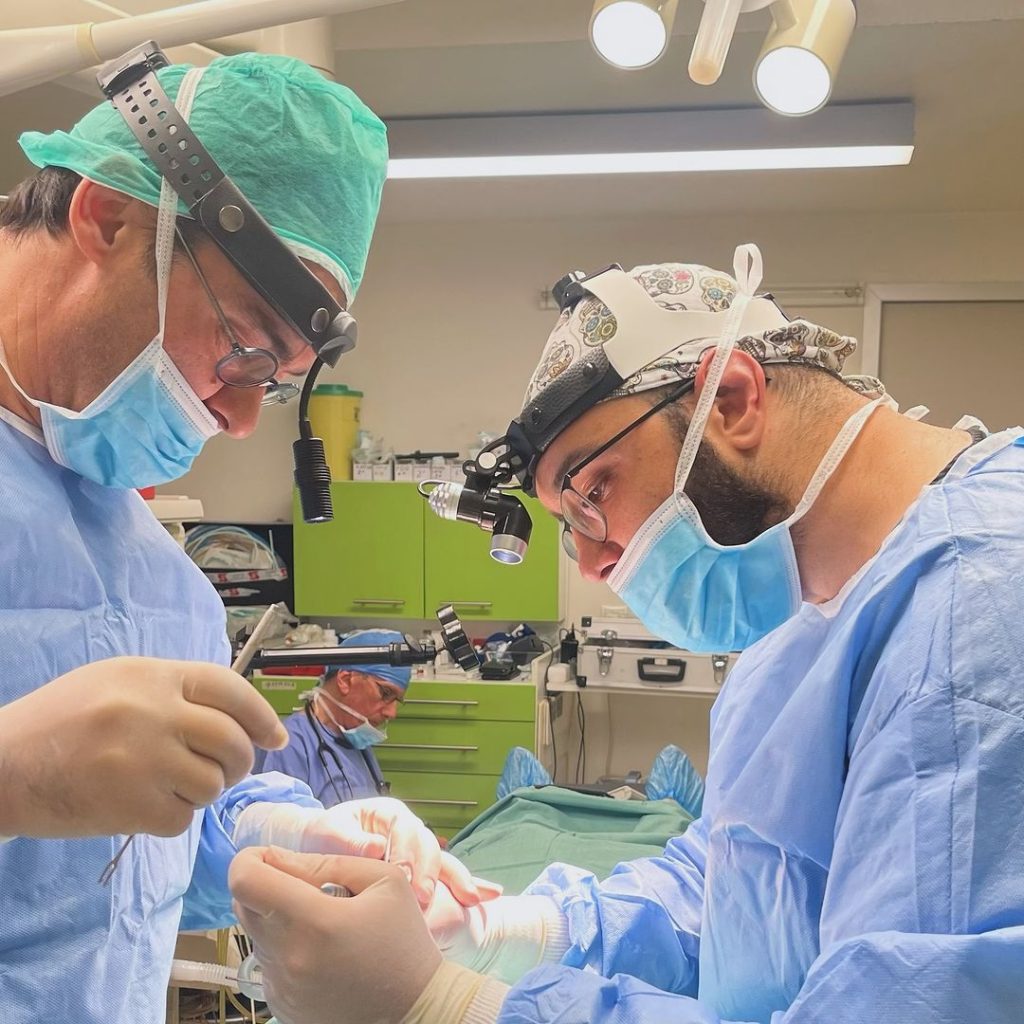
Alarplasty is a surgical procedure performed to reduce the nostril and wing. The procedure is customized to meet the patient’s aesthetic and functional needs. First, the surgeon conducts a detailed consultation with the patient about the expected results. During this consultation, the surgeon marks the areas to be corrected. The type of anesthesia for the operation is determined based on the surgeon’s recommendation and the scope of the procedure. Usually, general anesthesia is not required for alarplasty; local anesthesia may be sufficient.
Pre-operative preparation:
- The patient should arrange for a companion to accompany them before the operation.
- Generally, general anesthesia is not required for alarplasty, but this may vary depending on the situation.
During the procedure:
- The surgeon makes a precise incision in the designated areas.
- The incision allows for the removal of excess tissue.
- Then, sutures are placed for the new shape of the alar base.
- After the procedure, the incision area is covered with a bandage.
After the procedure, the patient is given pain relievers and care instructions. The patient needs to wear the bandage for a few days. The recovery process after alarplasty is faster compared to other facial surgeries. It is normal for the nose to be red and swollen for the first few days. This usually decreases within one to two weeks.
Recovery process:
- The stitches are removed within the first week.
- The full recovery process varies between one to three months.
The alarplasty procedure increases the patient’s facial symmetry while also improving breathing capacity. This procedure is preferred as it provides both aesthetic and functional improvement.
What Are the Possible Risks of Nostril and Wing Reduction Surgery?
Complications that may occur after alarplasty are a natural part of surgical interventions. Local swelling and redness may occur within the first few days after changes to the skin. Mild bleeding may also be observed during this period. Some risks stand out during the healing phase:
- Formation of scars
- Fluid or pus discharge from the surgical area
- Risk of infection
6 Reasons to Get Alarplasty in Istanbul



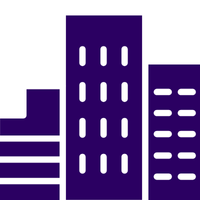


Post-OP
Care
Alarplasty Before & After Photos in Turkey
Can Rhinoplasty Reduce Nostrils?
Rhinoplasty is a method usually preferred to improve the structure of the nose. During this surgical procedure, it is possible to reduce the nostrils. The procedure allows for aesthetic adjustments to the width of the nostrils and the size of the nasal wings. Disproportion between the nostrils is especially eliminated. During the procedure, the sizes of the nostrils are adapted to the patient’s facial structure.
A detailed assessment is made before the operation. The specialist doctor examines the patient’s overall health status and facial anatomy to make appropriate planning. The techniques used during the operation are determined according to the patient’s needs. Reducing the nostrils with rhinoplasty includes:
- Reducing the size of the nostrils
- Achieving a more harmonious shape of the nasal wings
- Increasing facial symmetry
After the operation, the patient’s new nasal structure gains a more proportional appearance. The nostrils are reshaped aesthetically. Patients express satisfaction with the size of their nostrils after the operation.
Advantages of Nostril Reduction Surgery
For individuals with wide nasal wings, nostril reduction surgery offers many aesthetic and functional benefits. After this procedure, patients achieve a nasal structure that better suits their facial features. The symmetry in the central part of the nose significantly increases facial beauty. Additionally, reducing the nostrils improves respiratory functions, providing noticeable relief in daily life.
The benefits achieved with this surgical procedure are as follows:
- A more balanced nasal appearance is achieved.
- Symmetrical nostrils are provided.
- Noticeable ease in breathing is felt.
- Increased self-confidence is observed.
Post-Operative Care for Nostril and Wing Reduction Surgery
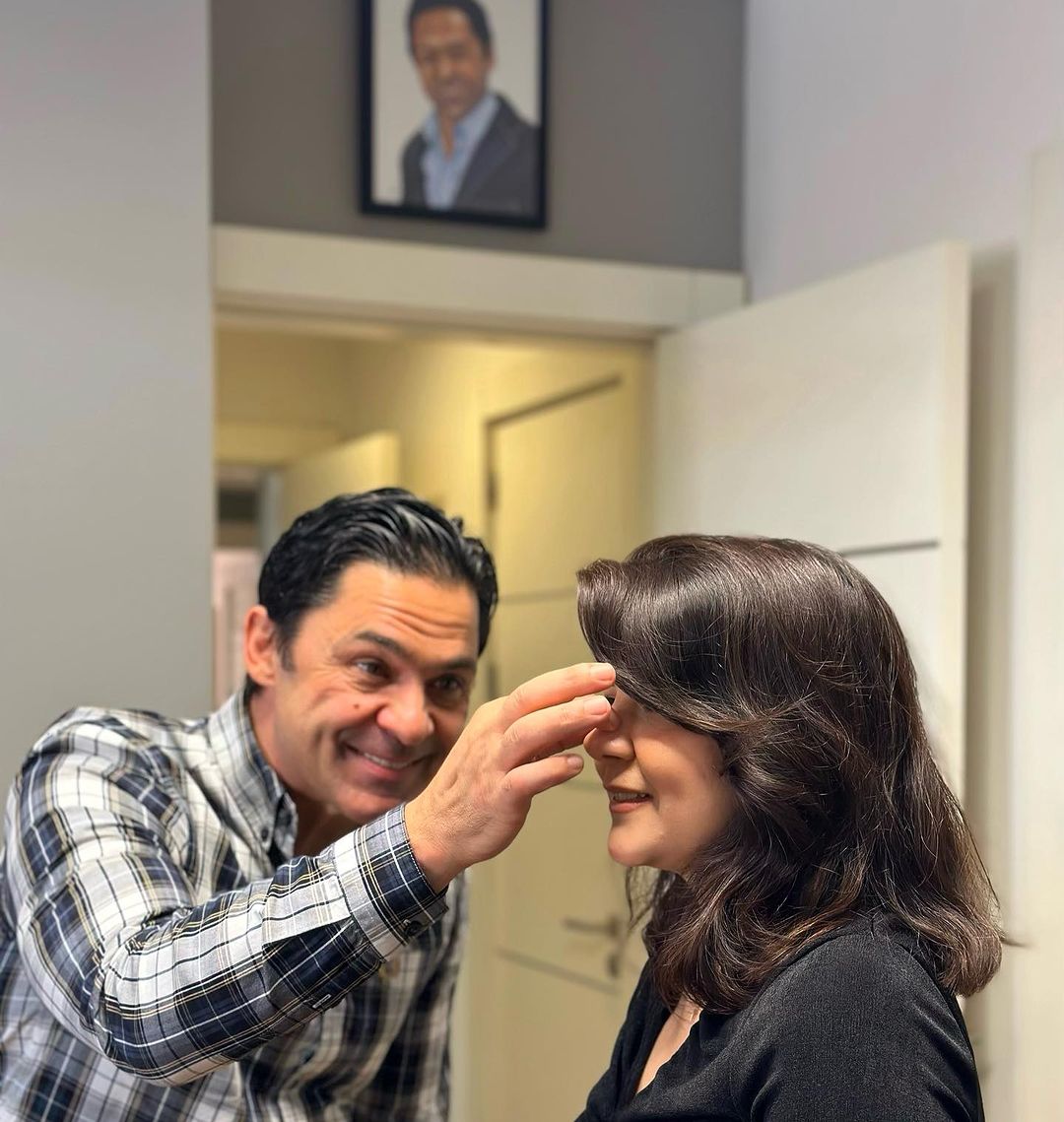
After nostril and wing reduction surgery, patients need to pay attention to important points to positively influence the healing process and ensure the permanence of the surgery’s effects. Strictly following the recommendations of your specialist doctor minimizes potential health risks and facilitates achieving the desired aesthetic results.
Firstly, it is essential to take the medications prescribed by your doctor regularly. These medications are necessary to reduce the risk of infection and control pain. The bandages should be kept clean and dry according to care instructions. Additionally, attending planned follow-up appointments on time ensures that the process is progressing correctly.
- Resting for the first few days is critical for healing.
- Keeping your head elevated while sleeping helps reduce swelling.
- Using ice packs as recommended by your doctor can reduce swelling and bruising.
- Nasal sprays or drops recommended by your doctor facilitate breathing and reduce internal nasal swelling.
During the post-operative period, it is necessary to limit physical activities. Heavy lifting, strenuous exercises, or participating in sports activities can negatively affect the healing process and lead to complications.
Paying attention to your eating habits supports your overall health and accelerates healing. Avoiding alcohol and smoking can further speed up the healing process and reduce the risk of complications.
Finally, avoiding stress, getting enough rest, and relaxing support the overall healing process. If you wear glasses, it is important to avoid them during this period and avoid situations that may put pressure on the nose. If you experience any issues during the healing process, it is essential to contact your doctor and get timely intervention.
How Much Does a Alarplasty in Turkey in 2025 ?
The cost of a Alarplasty in Istanbul, Turkey, typically ranges between €5,000 and €7,000. The price can vary depending on several factors, such as the surgeon's experience, the complexity of the procedure, the clinic's reputation, and additional services included in the package.
| Average Alarplasty Cost (in Euros) in 2025 | |
| United Kingdom | €16,600 – €19,000 |
| United States | €14,200 – €23,400 |
| Canada | €16,000 – €19,000 |
| Australia | €23,800 – €37,800 |
| South Korea | €9,400 – €17,200 |
| Ireland | €13,000 – €15,000 |
| Germany | €11,000 – €13,000 |
| Netherlands | €11,000 – €13,000 |
| France | €11,000 – €13,000 |
| Turkey | €5,000– €7,000 |
Frequently Asked Questions
Can nostrils be reduced during nose surgery?
Nostril reduction can be performed during rhinoplasty surgeries. The size of the nostrils can be reduced through various techniques. This procedure allows for the controlled reduction of the nostrils. At the same time, it helps prevent weakening of the wing cartilages, thereby avoiding breathing problems. Thus, during rhinoplasty, both aesthetic and functional improvements are achieved.
How long does nostril reduction surgery take?
The duration of nostril reduction surgery depends on the complexity of the surgical procedure. Generally, this type of operation is planned according to the patient’s specific condition and the surgeon’s experience. Thus, the operation can take between 1 to 3 hours. In cases requiring detailed correction, the duration of the surgery may be extended. The choice of surgical techniques according to the patient’s needs also affects the duration. The most appropriate duration for each patient is determined after a detailed pre-operative assessment.
How long does it take to heal after nasal wing reduction?
The recovery process after nasal wing reduction surgery is generally short. However, this process can vary depending on the patient’s skin type and overall health condition. In individuals with thin skin, healing may be faster. Typically, the full recovery process after nasal wing reduction takes between a few weeks to a few months. During this period, the patient reduces side effects such as swelling and bruising. Although each patient’s recovery process is different, most people notice significant improvement within a few weeks.
How much does the nose reduce after nose surgery?
During rhinoplasty surgeries, the nasal volume is typically reduced by about 13%. This change not only provides an aesthetic appearance but also brings functional improvements. Most patients achieve a more aesthetic nasal structure and experience significant relief in breathing functions thanks to this reduction. It is important to maintain nasal functions while making aesthetic improvements. This balanced approach ensures satisfactory results both in form and function after the operation.
What can be done if the desired result is not achieved after nostril and wing reduction surgery?
If the desired results are not achieved after nostril and wing reduction surgery, revision surgery can be considered. This procedure is usually performed under local anesthesia. During the revision, the nostrils or wings are reshaped. It is also important to carefully monitor the recovery process and strictly follow the doctor’s recommendations. If aesthetic concerns persist, a detailed evaluation with the doctor can determine appropriate treatment options. This process is important to meet the patient’s desires.
How is the breathing function affected after nostril and wing reduction surgery?
The breathing function generally improves after nostril and wing reduction surgery. Patients may experience swelling and congestion for the first few days. However, these symptoms gradually decrease, providing relief. The main goal of the surgery is to make the nostrils and wings more proportionate. Thus, both aesthetic and functional improvement is achieved. Patients begin to breathe more easily. Full recovery and increased comfort in breathing typically occur within one to three months.
Are the nasal wings cut during nose surgery?
During closed rhinoplasty, the nasal wings are not cut from the outside. Incisions are made on the inside of the nostrils. This technique is preferred to change the shape of the nose without leaving external scars. However, in some cases, internal incisions may not be sufficient, and external incisions may be required. This depends entirely on the individual’s nasal structure. In most patients, aesthetic surgeries are successfully performed with the closed technique, and external incisions are not necessary.
Is it possible to narrow the nasal wings without surgery?
It is not possible to narrow the nasal wings without surgery. Non-surgical methods provide only temporary solutions and do not structurally narrow the nasal wings. Alternatives such as fillers or makeup techniques only create a visual illusion. However, surgical procedures are necessary to achieve permanent narrowing of the nasal wings. Such changes involve reshaping the tissues and arranging the cartilage. Therefore, surgery is the only effective solution for those seeking permanent results.
When do the nasal wings settle?
The nasal wings usually take 6 months to 1 year to fully settle. However, this process progresses slowly. It is important to evaluate the main outlines once the nose is unwrapped. It may take months to see the final result. Patience is required for the nasal wings to take their final shape. As the results will appear over time, it is important to be patient.
Can a crooked nostril be corrected with surgery?
A crooked nostril can be corrected with surgery. In the early days, asymmetry issues in the nostrils may be experienced, but this is usually temporary. As the nose heals and the swelling subsides, the nostrils become symmetrical. Crooked nostril surgery can be performed under local anesthesia and followed by simple dressings. Over time, the shape of the nose improves, and the nostrils regain their normal appearance. Therefore, a crooked nostril can be successfully corrected with surgery.
One of the Best Clinic Team for Alarplasty in Turkey
Dr. Alev Camcıoğlu is considered to be one of the best Alarplasty surgeon in Turkey. You can check Alarplasty reviews here.

Op. Dr. Alev Camcıoğlu
Rhinoplasty Surgeon
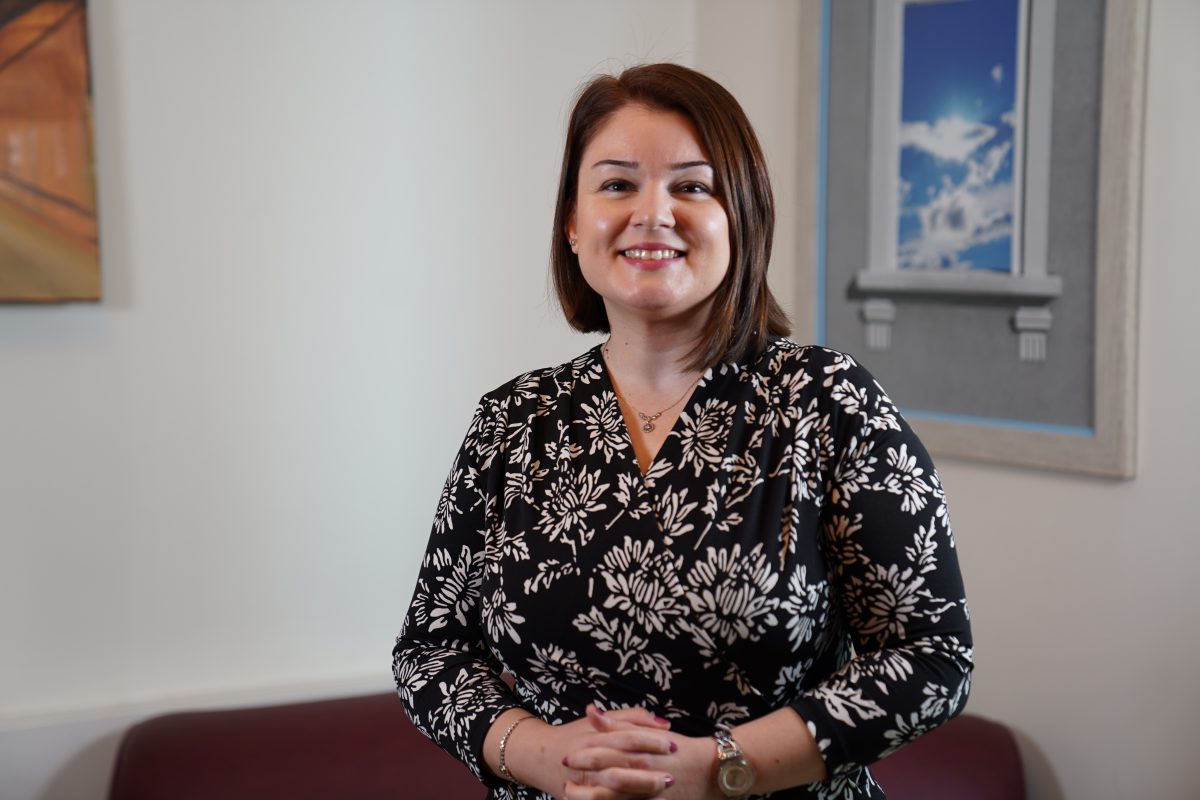
Aylin Uyuşmak
Clinical Coordinator

Serra Sevgili
Clinical Assistant

Sema Yapıcı
Operating Room Nurse



